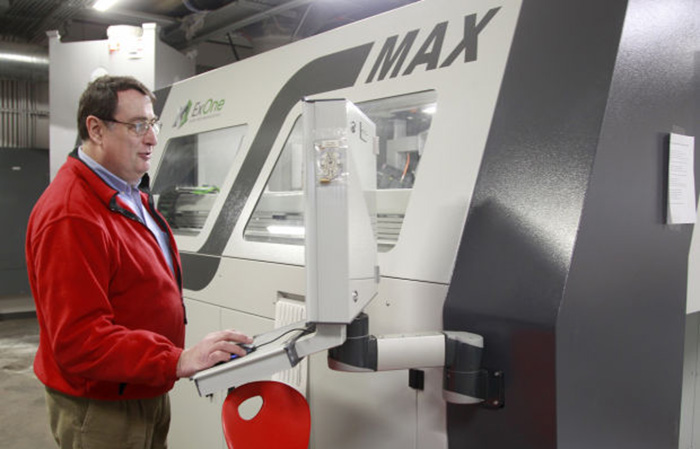Last September, UNI’s Metal Casting Center took possession of one of the largest 3D printers in the US, ExOne’s S-Max. The printer is large enough to produce objects up to almost six feet long (70” in the X axis), building each layer up 1/7000th of an inch using specially engineered sand coated in resin and can complete an object the size of its massive job box at a rate of 45 minutes per square inch.
The Iowa Department of Economic Development paid 1.2 million of the 1.5 million dollar price tag, and it only took Metal Casting Center director Jerry Thiel two years to convince them to do it. The university can easily make up the difference by selling use of the printer to private businesses, including national corporations like John Deere and Honeywell Aerospace who have already been working with the university for new and advanced training for their employees.
If you’re not familiar with the S-Max, the massive 3D printer uses multiple varieties of specially engineered sand mixed with a resin binding agent to print objects on the ridiculously massive 6 foot by 3 and a half foot printing bed. A robotic arm spreads a uniform layer of sand less than three grains deep. Once the first layer of sand has been laid a layer of resin in the pattern of the object being printed is sprayed down and then covered with another layer of sand. Using this process, the printer can produce a staggering 3,000 pounds of moulds and objects at a time.
“The flexibility we have with this unit is amazing,” said Thiel. “We can do things that other people can’t.”
Not only is the printer a huge (literally and figuratively) asset for the national businesses who save time and money on mould making and prototyping by having access to it, but students are able to work with cutting-edge technology doing work that will be instantly applicable to new manufacturing jobs as well as researching ways to improve 3D printing technology. Additionally, any revenue generated, once the printer is paid off, will go directly to the Metal Casting Center who is looking to develop an Advanced Manufacturing Center at the university by adding a direct-to-metal 3D printer to their workshop.
It’s a no-brainer to give students access to advanced 3D printing and manufacturing equipment, after all they’re the ones who will get to live in the world produced by these machines. And not for nothing, but I really hope that the first test print that they did was for one of these on the right:
I’m going to be a little disappointed if they didn’t. Watch an S-Max demo here:




